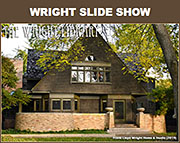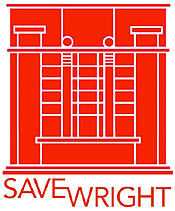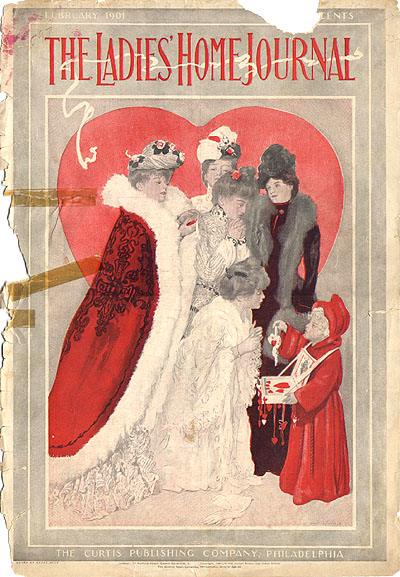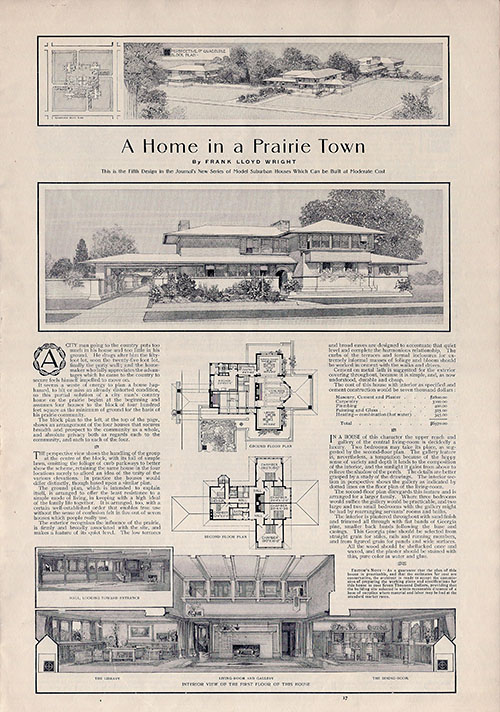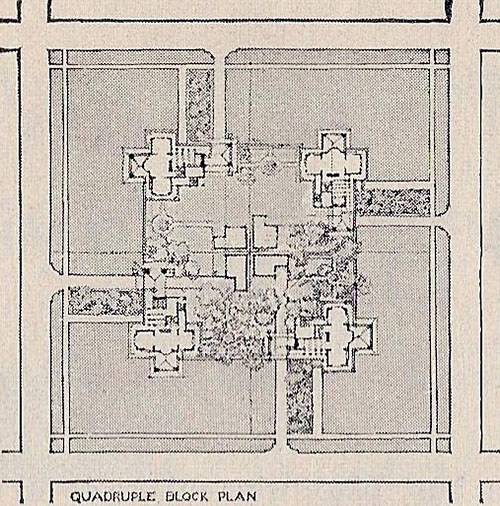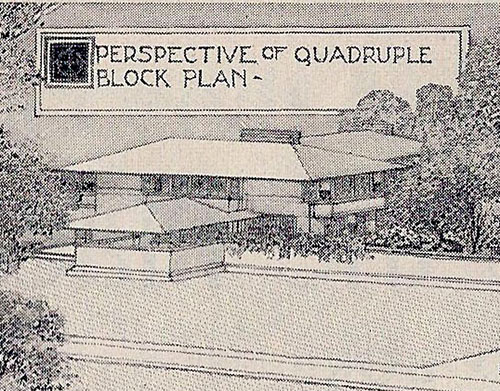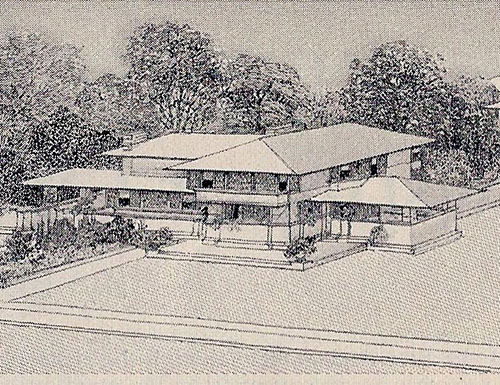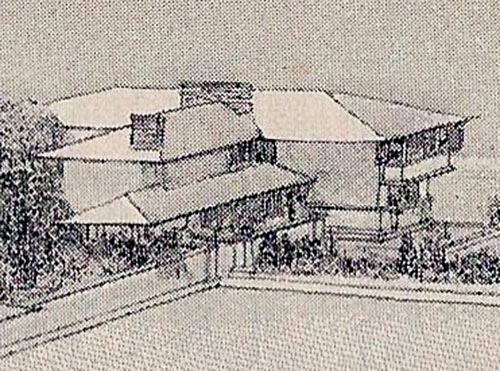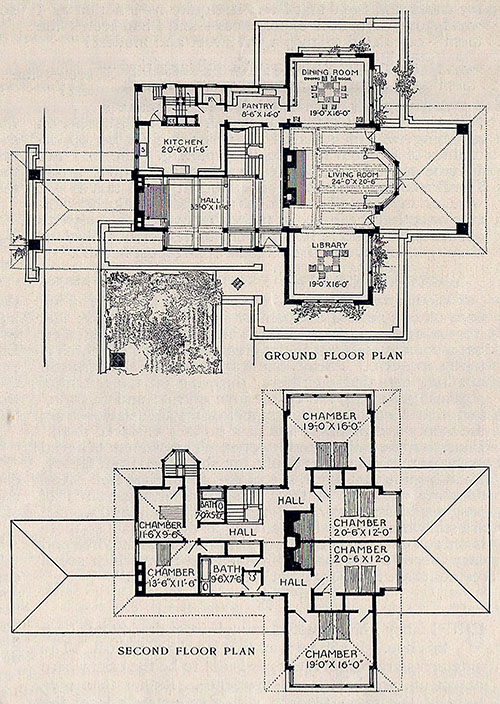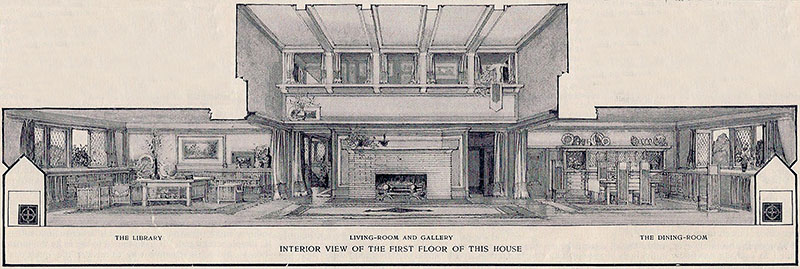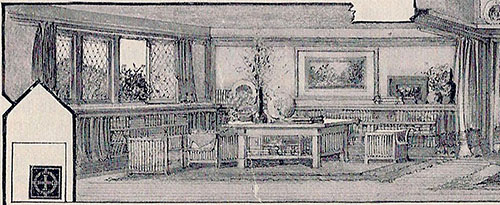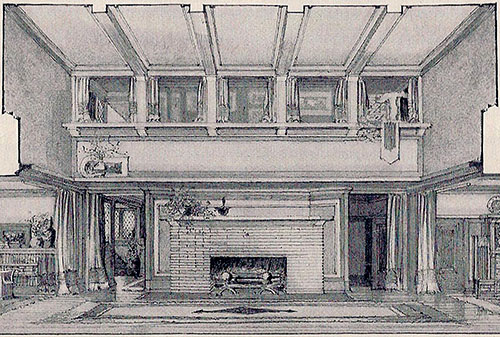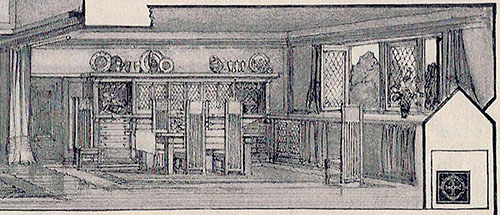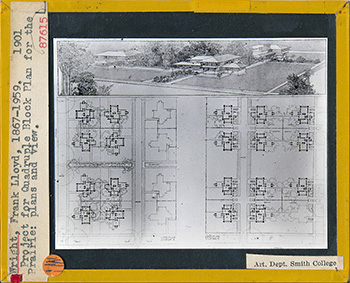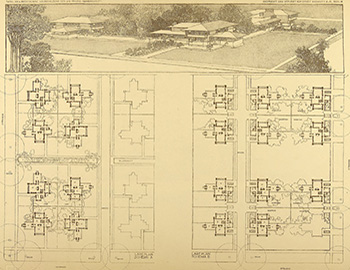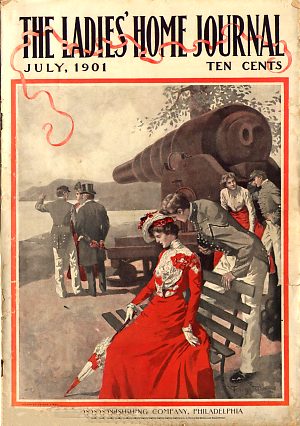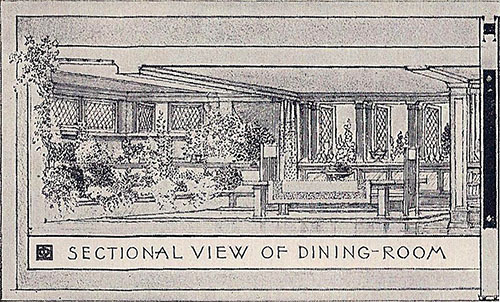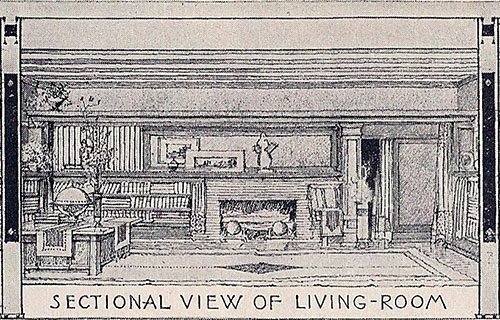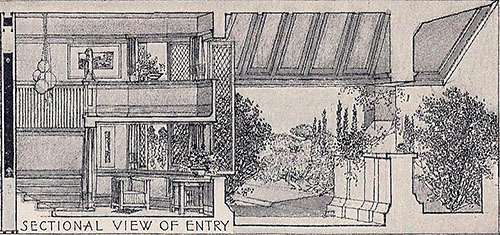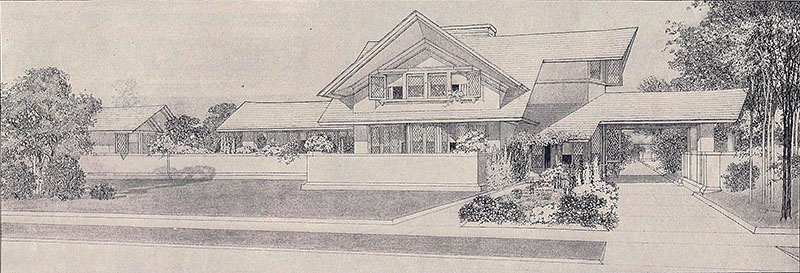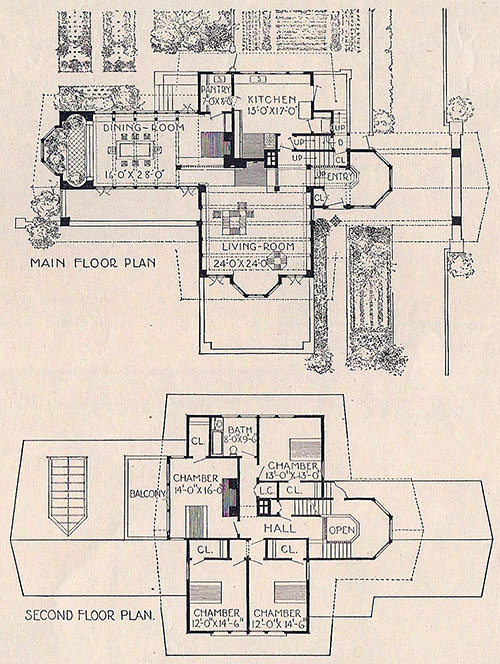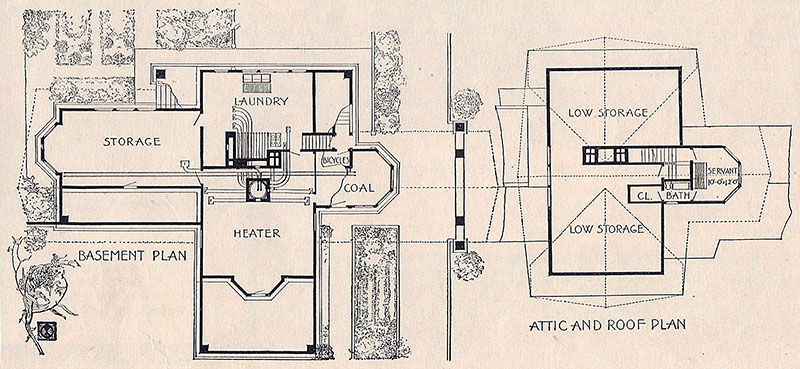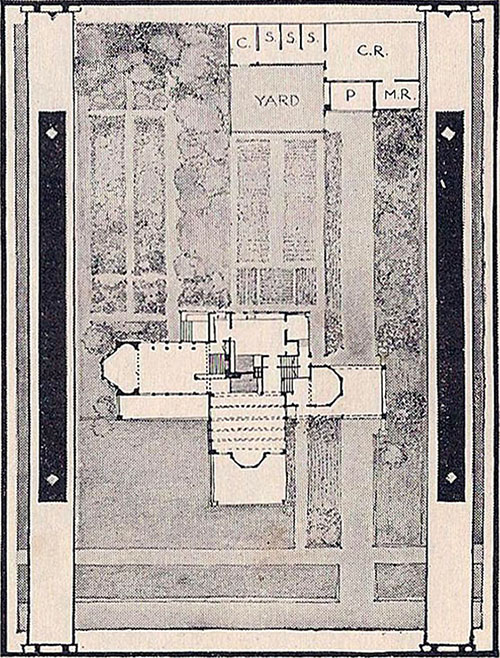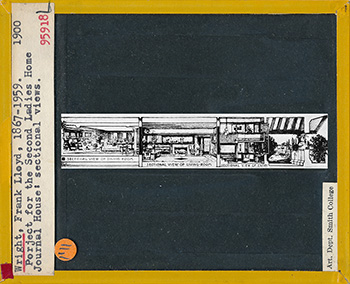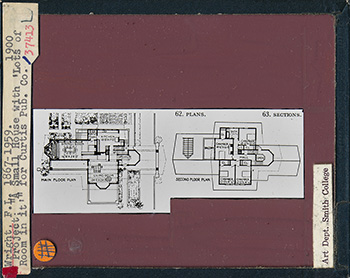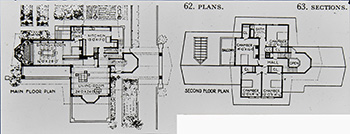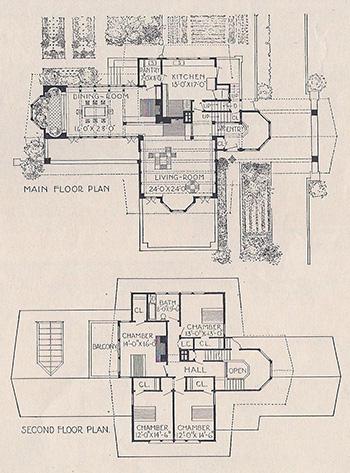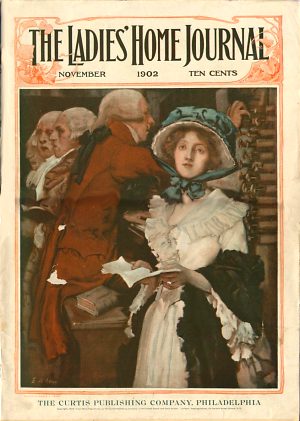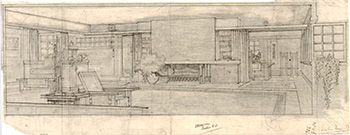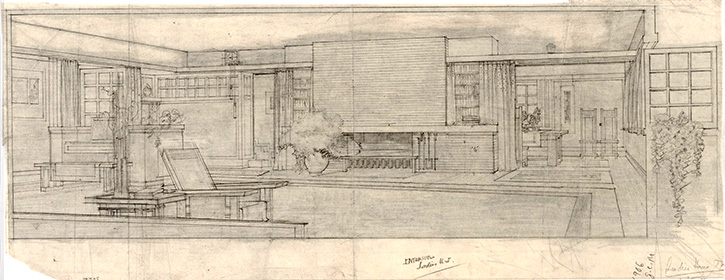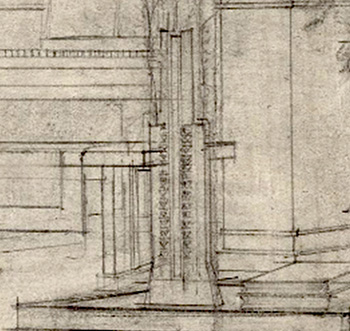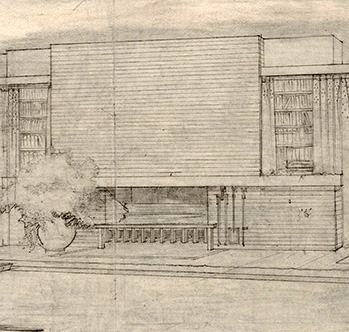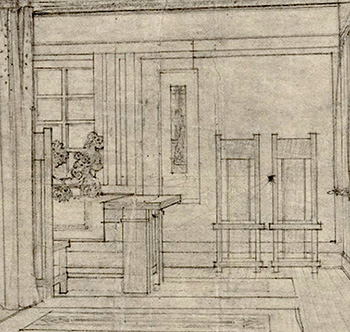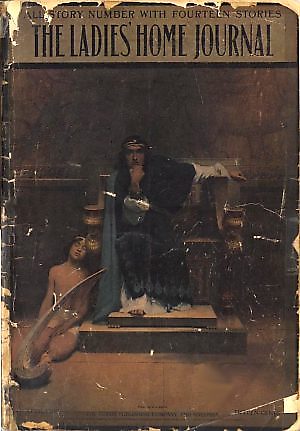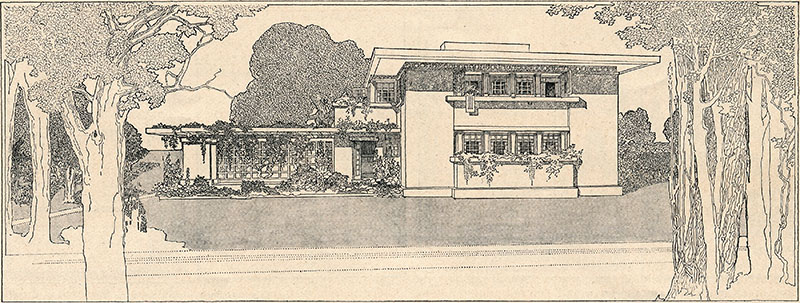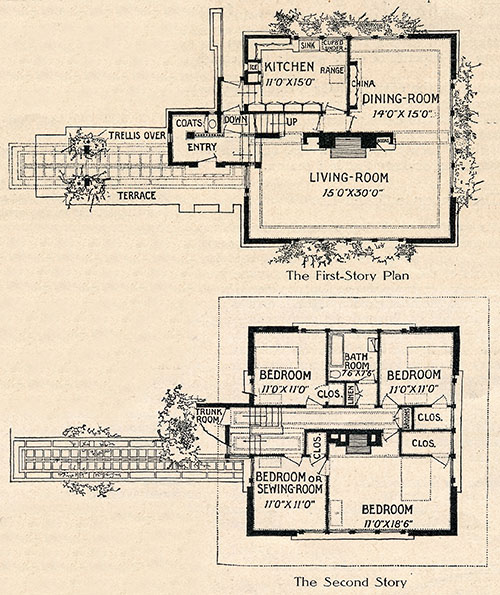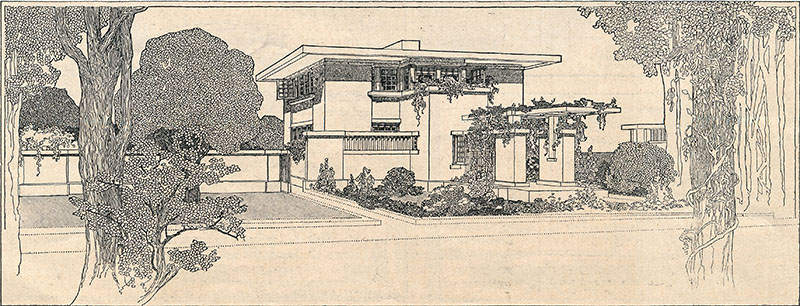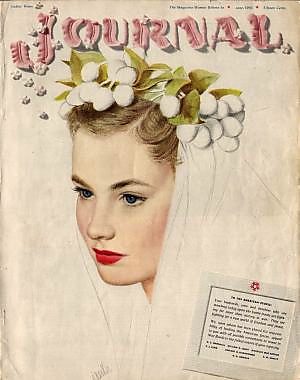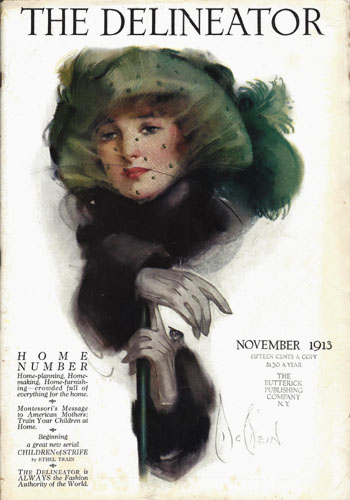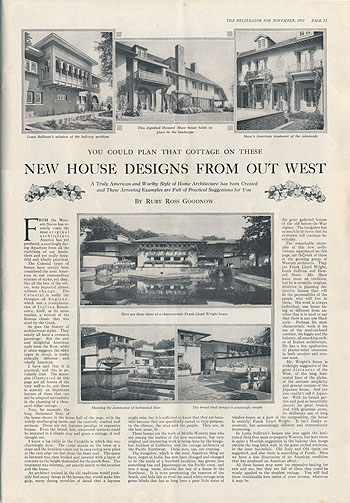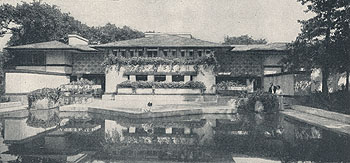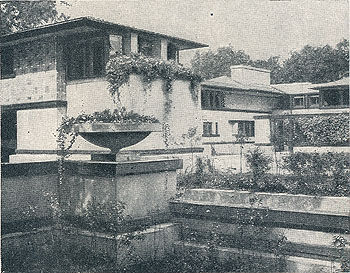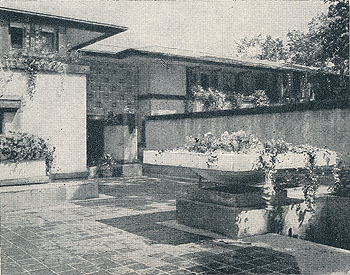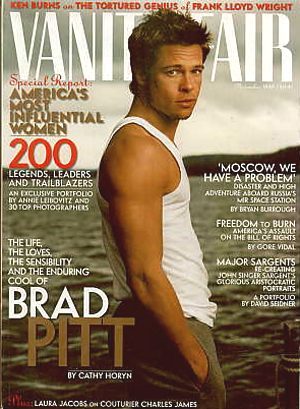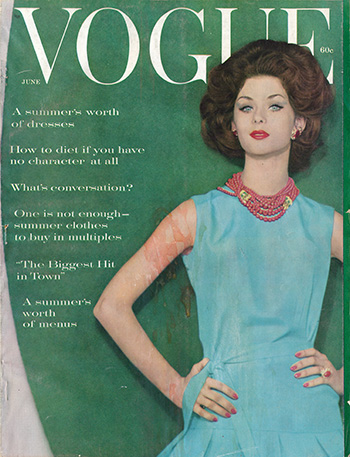
SUPPORT THE
WRIGHT LIBRARY
PROCEEDS FROM EVERY SALE GOES TO SUPPORT THE WRIGHT LIBRARY.
CLICK TO ORDER.
WE PROUDLY SUPPORT THE FRANK LLOYD WRIGHT FOUNDATION

WE PROUDLY SUPPORT THE FRANK LLOYD WRIGHT BUILDING CONSERVANCY
WE PROUDLY SUPPORT FALLINGWATER
AND THE WESTERN PENNSYLVANIA CONSERVANCY

LADIES' HOME JOURNAL THE DELINEATOR VANITY FAIR VOGUE THE LADIES' HOME JOURNAL Date: 1901 Periodical: Ladies' Home Journal - February 1901 (Published Monthly by The Curtis Publishing Company, Philadelphia)
Author: Wright, Frank Lloyd
Description: "A Home in a Prairie Town." Full page article of a Prairie house designed by Frank Lloyd Wright. "A city man going to the country puts too much in his house and too little in his ground. He drags after him the fifty-foot lot, soon the twenty- five- foot lot, finally the party wall; and the home- maker who fully appreciates the advantages which he came to the country to secure feels himself impelled to move on.
It seems a waste of energy to plan a house hap-hazzard, to hit or miss an already distorted condition, so this partial solution of a city man's country home on the prairie begins at the beginning and assumes four houses to the block of four hundred feet square as the minimum of ground for the basis of his prairie community.
The block plan to the left, at the top of the page, shows an arrangement of the four houses that secures a breadth and prospect to the community as a whole, and absolute privacy both as regards each to the community, and each to each of the four.
The perspective view shows the handling of the group at the centre of the block, with its foil of simple lawn, omitting the foliage of curb parkways to better show the scheme, retaining the same house in the four locations merely to afford an idea of the unity of the various elevations. In practice the houses would differ distinctly, though based upon a similar plan..." Includes seven illustrations of "A Home in a Prairie Town." Original cover price 10 cents. 11 x 16.5. (Sweeney 45)Size: 11 x 16.5
Pages: Pp 17
S#: 0045.00.0207
Date: 1901
Title: Project For Quadruple Block Plan for the Prairie. Vintage 4" x 3.25"
Description: Magic Lantern Slide of Quadruple Block Plan published in the Ausgefuhrte Bauten und Entwurfe von Frank Lloyd Wright, 1910, Plate XIIIa. Frank Lloyd Wright introduced the concept for the Quadruple Block Plan in the February, 1901 issue of Ladies' Home Journal, as part of A Home in a Prairie Town.
When Frank Lloyd Wright published Ausgefuhrte Bauten und Entwurfe in 1910, Plate XIII repeated the 1901 single home illustration, Plate XIIIa repeated the 1901 aerial view and elaborated his theory on the Block Plan. This slide is a copy of Plate XIIIa.
In 1913, Wright expanded his theory including it in his plan for the city in the Chicago City Club competition. He wrote of quadruple re-subdivision by grouping four separate homes together in "sub-blocks". He continued to developed the principle of the quadruple block plan. Wright’s plan was published in City Residential Land Development, 1916, pp. 96-102. Illustrations were printed in color.
Magic lantern slides were used in the U.S. during the late 1800s through the first half of the 1900s. Text: “Sectional View of the Dining Room. Sectional View of the Living Room. Sectional View of Entry.”
Text on face of slide: “Wright, Frank Lloyd, 1867-1959. 1901 (sic 1910). Project for Quadruple Block Plan for Prairie: plans and view. 87615. Art Dept Smith College.” Acquired from the Art Department at Smith College.
Size: Magic lantern slide 4" x 3.25", Transparency: 3" x 2.4"
S#: 0045.01.0725
Left: Detail of Magic Lantern Slide.
Right: Detail of the Ausgefuhrte Bauten
und Entwurfe von Frank Lloyd Wright,
1910, Plate XIIIa.Date: 1901 Periodical: Ladies' Home Journal - July 1901 (Published Monthly by The Curtis Publishing Company, Philadelphia)
Author: Wright, Frank Lloyd
Description: A Small House with ‘Lots of Room in It.’ Full page article of a Prairie house designed by Frank Lloyd Wright. "The average home-maker is partial to the gable roof. This house has been designed with a thorough, somewhat new treatment of the gable with gently flaring eaves and pediments, slightly lifted at the peaks, accentuating the perspective, and modeling the roof surfaces and making the outlines ‘crisp.’
The plan disregards somewhat the economical limit in compact planning to take advantage of light, air and prospect, the enjoyable things one goes to the suburbs to secure. With modern systems of heating a distinct freedom in arrangement, denied to earlier builders, is made not only possible, but may be made comfortable with modest outlay. Two large rooms, with an entry performing the function of a little, formal social office, or a waiting-room, to relieve the living room of undesirable pressure, together with a simple arrangement of stairs and a working department, make up the scheme of the main floor..."
Although not an exact copy of the Bradley House (1900 - S.052). there are many similarities. To some degree, is a scaled down version of the Bradley House. Includes ten illustrations of A Small House with ‘Lots of Room in It.’ Original cover price 10 cents. 11 x 16.5. Two Copies. (Sweeney 46)Size: 11 x 16.5
Pages: Pp 15
S#: 0046.00.0900, 0046.01.0900
Date: 1901
Title: Vintage 4" x 3.25" Magic Lantern Slide of a sectional view published in the Ladies' Home Journal - July 1901.
Description: Copy photograph of the an illustration published in the Ladies' Home Journal - July 1901 (Sweeney 46). A Small House with ‘Lots of Room in It.’ A full page article of a Prairie house designed by Frank Lloyd Wright. At the top of the page is a sectional view of the Dining Room, Living Room and Entry. Magic lantern slides were used in the U.S. during the late 1800s through the first half of the 1900s. Text: “Sectional View of the Dining Room. Sectional View of the Living Room. Sectional View of Entry.”
Text on face of slide: “Wright, Frank Lloyd, 1867-1959. 1900 (sic 1901). Project for the Second Ladies' Home Journal House: sectional views. 95918. Art Dept Smith College.” Acquired from the Art Department at Smith College.
Size: Magic lantern slide 4" x 3.25", Transparency: 3" x .6"
S#: 0046.01.0725Magic lantern slide detail. Detail from July 1901 issue of Ladies' Home Journal. Date: 1901
Title: Vintage 4" x 3.25" Magic Lantern Slide of the Floor Plan for the Small House with ‘Lots of Room in It,’
Description: Copy photograph of the floor plan for the Small House with ‘Lots of Room in It,’ published in the Ladies' Home Journal - July 1901 (Sweeney 46). A Small House with ‘Lots of Room in It.’ A full page article of a Prairie house designed by Frank Lloyd Wright. In the center of the page, and and just below it are floor plans for the house.
These floor plans were published again in In The Nature of Materials, Hitchcock, 1942, Plates 62 and 63. This slide is a copy of plates 62 and 63. Magic lantern slides were used in the U.S. during the late 1800s through the first half of the 1900s. Text: “Sectional View of the Dining Room. Sectional View of the Living Room. Sectional View of Entry.”
Text on face of slide: “Wright, F. L. , 1867-1959. 1900 (sic 1901). Project: A Small House with Lots of Room in it, for Curtis Pub. Co. 37413. Art Dept Smith College.” Acquired from the Art Department at Smith College.
Size: Magic lantern slide 4" x 3.25", Transparency: 3" x 1.25"
S#: 0046.02.0725
Left: Detail of Majic Lantern Slide above.
Right: Detail published in the Ladies'
Home Journal - July 1901Date: November 1902 Periodical: Ladies' Home Journal - Nov 1902
Author:
Description: (Photo - Frank Lloyd Wright Dining Room)
Size:
Pages: Pp 8
S#: 0052.01.0701
Date: January 1903 Periodical: Ladies' Home Journal - January 1903
Author:
Description: Inside of a hundred suburban homes (Photo - Frank Lloyd Wright Dining Room)
Size:
Pages: Pp 24
S#: 0054.01.0400
Date: 1906
Title: Ladies' Home Journal houses. "A Fireproof House for $5000." 1906 (FLLW #0614) (Project).
Description: Perspective view of the Living Room for the Ladies' Home Journal houses' Fireproof House. Frank Lloyd Wright designed the house in 1906 and it was published in April 1907. There are 11 drawings in the Frank Lloyd Wright Archives, Avery Library, Columbia University. Four of which were published in in the Ladies' Home Journal. Although this house was never built, Wright utilized the concept in a number of other designs that were completed. He also published the drawings again in the Ausgefuhrte Bauten folios, 1910, Tafel XIV (14) and XIVa (14a).
This living room has all the ear-marks of a Wright designed prairie styled living room. Furniture, fireplace, Japanese Print, and even a “Skyscraper” vase.
It is interesting to note that S. C. Johnson & Son used this illustration in an ad in The American Architect, July 26, 1914. Courtesy of the Frank Lloyd Wright Archives, Avery Library.
Size: 10 x 4 Color photograph.
S#: 0064.59.1225Date: 1907 Periodical: Ladies' Home Journal - April 1907 (Published Monthly by The Curtis Publishing Company, Philadelphia)
Author: Wright, Frank Lloyd
Description: "A Fireproof House for $5000." Half page article of a fireproof house designed by Frank Lloyd Wright. "The cost of building has increased nearly forty per cent in the past six years. The thirty- five- hundred- dollar wooden house of six years ago would cost nearly five thousand dollars now; so at the present time it would seem that five thousand dollars ought to represent a low enough cost standard, if the result be permanent and the cost of maintenance lessened.
Changing industrial conditions have brought reinforced concrete construction within the reach of the average home-maker. The maximum strength peculiar to the nature of both concrete and steel is in this system utilized with great economy. A structure of this type is more enduring than if carved intact from solid stone, for it is not only a masonry monolith but interlaced with steel fires as well. Insulated with an impervious non-conducting inner coating it is damp-proof; it is, too, warmer than a wooden house in winter and cooler in summer.
The plan for a small house of this type, submitted here, is the result of a process of elimination due to much experience in planning the inexpensive house. What remains seems sufficiently complete and the ensemble an improvement over the usual cut-up, over trimmed boxes doing duty in this class, wherein architecture is a matter of ‘millwork’ and the ‘features’ are apt to peel.
As an added grace in summer foliage and flowers are arranged for as a decorative feature of the design, the only ornamentation. In winter the building is well proportioned and complete without them..." Includes four illustrations of "A Fireproof House." (Sweeney 80)Size: 11 x 16.5.
Pages: Pp 24
S#: 0080.00.0501
Date: June 1945 Periodical: Ladies' Home Journal - June 1945
Author: Murdock, Henrietta
Description: Accent on Living. Opus 497. The intriguing room... is the everyday family room of our latest postwar house... floor-to-ceiling windows, with the drama of all outdoors for a background. This new kind of room has been made to fit the family and its everyday family activities, so you can play, read, eat, talk and study all in the same big area. ...the architect has suggested furniture that can be moved easily and assembled in spots about the room as needed for any particular purpose. An indoor garden such as you see in the picture is every woman's dream. Think of having spring shrubs, fragrant herbs and seasonal flowers growing right inside, filling the room with their odor the year around... Mr. Wright has planned many of America's most distinguished modern houses, each forward-looking but practical. In this one you will find many advanced ideas of the kind we grow into and appreciate later on... (Sweeney 636) For more information see our Wright Study on Opus 497.
Size:
Pages: Pp 141
S#: 0636.00.0502
Date: June 1945 Periodical: Ladies' Home Journal - June 1945
Author: Pratt, Richard
Description: Opus 497. The world’s most distinguished architect designs a crystal house, for town or country, which can have far-reaching effects on future living for all of us. For more than half a century Frank Lloyd Wright has been performing feats of architecture noted for their freshness and originality, and his influence on building all over the world has hardly been equaled by any architect of our time. All this would have been sufficient reason for us to be pleased to publish his most recent house design, Opus 497, done especially for the Journal, and in our opinion one of his finest... Seven of the models created for the LHJ, were the focus for the exhibition "Tomorrow’s Small House: Models and Plans" held at MOMA from May 29 - September 30, 1945. Also included in the exhibition was a model of a row-house and a neighborhood development. Originally created to enable color photographs to be taken of the models for the magazine, the models were so complete and detailed they made excellent displays. (Sweeney 644) For more information see our Wright Study on Opus 497.
Size:
Pages: Pp138-9
S#: 0644.00.0502
THE DELINEATOR Date: 1913 Title: The Delineator - November 1913 (Published monthly by The Butterick Publishing Company, New York)
Author: Goodnow, Ruby Ross
Description: "You Could Plan That Cottage on These New House Designs From Out West. From the Western States has recently come the most original architecture America has yet produced, a startlingly daring departure from all the traditions of our forefathers and yet really beautiful and wholly practical... The remarkable examples of this new architecture, reproduced on this page, are the work of three of the growing group of western architects. They are Frank Lloyd Wright, Louis Sullivan and Howard... Mr. Wright’s house is strikingly suggestive of the great distances of the West, of the long horizontal lines of the plains, of the extreme simplicity and general contour of the Japanese house. And yet you couldn't call it Japanese. With its formal garden and pool so beautifully placed, its great broken roof with generous eaves, its deliberate use of long window-boxes as a part of the composition, the house is entirely Frank Lloyd Wright. It isn't freaky or eccentric, but astonishingly different and tremendously interesting." Includes three photographs of the Coonley Residence, one of the Babson Residence (1911) by Sullivan, and two by Shaw. Original cover price 15c.
Size: 11.25 x 16
Pages: Pp 21
S#: 0120.17.0515
VANITY FAIR Date: 1998
Title: Vanity Fair - November 1998
Author: Ken Burns
Description: The Master Builder
Size:
Pages: Pp 54, 302 - 318
ST#: 1998.01.0599VOGUE MAGAZINE Date: 1960
Title: Vogue Magazine - June 1960 (Published monthly by Conde Nast Publications Inc., New York)
Author: Anonymous
Description: The Biggest Hit In Town - The Guggenheim Museum.
Into this great luminous swirl, designed by Frank Lloyd Wright, some 760,000 people - since the opening on October 21, 1959-have walked to see a magnificent collection, primarily abstractions, to argue architecture.
Because nothing succeeds like controversy combined with genius, the new Solomon R. Guggenheim Museum, which stars both, is unquestionably the biggest hit in town, considerably bigger in fact than Ethel Merman in Gypsy, housed in the largest theatre on Broadway. The most the musical can draw in a week is some fifteen thousand people, while the museum pulls about twenty-four thousand. No one expected this. Even Variety, usually confined to entertainment-world box office and news, had a small account of the Museum's extraordinary attendance record. By now, that score is 760,000.
People who ignored the original Museum when it was a dark and fancy place with velvet curtains, have rushed to look at the massive, cream-coloured eccentricity on Fifth Avenue, the unique "defective masterpiece" designed...
Includes one photograph and three cartoons of the Guggenheim Museum and one Portrait of Frank Lloyd Wright.
Size: 9.75 x 12.75
Pages: Pp 108-111, 157-158
S#: 1458.146.0925
HOME ARTIFACTS AUDIO BOOKS PERIODICALS PHOTOS POSTCARDS POSTERS STAMPS STUDIES ASSISTING ABOUT SLIDE SHOW To donate or pass on information, comments or questions:
steinerag@msn.com
©Copyright Douglas M. Steiner, 2001, 2026

